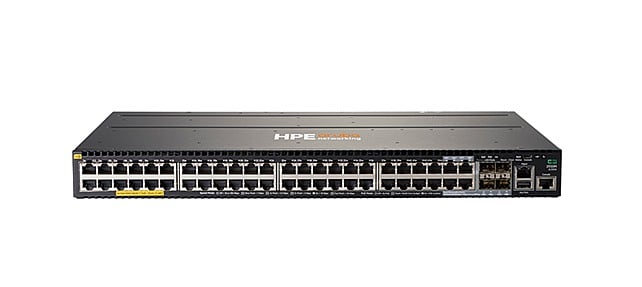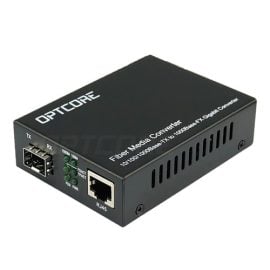Blog, Networking Device
What Is PoE Switch: A Complete Guide
PoE (Power over Ethernet) has become more important in the network industry. As this technology develops, many PoE devices come into the market. What is PoE switch? It is a device that transmits data and supplies power to connected devices via a single Ethernet cable.
This article explains the definition of this switch and its three types. It also analyzes the switch’s advantages and disadvantages, helping you decide which types fit your needs.
Table of contents
What Is PoE Switch
This switch uses one Ethernet cable to give powered devices (PD) power supply and network connection. It is a fast Ethernet or Gigabit network switch using Power over Ethernet technology. This switch passes data and power over twisted-pair Ethernet cables, such as RJ45, to IP phones, wireless access points, and basic IP cameras.
You may see a similar phrase: PoE Ethernet switch. Some users may forget the full name of PoE is Power over Ethernet. But this doesn’t matter. Google can still find what they need to search: the PoE switch.

The PoE technology has active PoE and passive PoE. The former, also known as standard PoE, means a PoE type that adjusts the voltage between the power sourcing equipment (PSE) and the PD. The latter, known as a non-standard PoE, sends power over Ethernet lines but cuts out the negotiation or communication step.
A PoE network switch, obeying an IEEE 802.3af standard, delivers power of up to 12.95W for a PD with a voltage range of 37V to 57V. When users install this switch, their devices work in areas without power outlets or network connections. It makes installation much simpler and costs less money.
What Is PoE+ Switch
These switches deliver power to a range of devices based on IEEE 802.3af, IEEE 802.3at, and IEEE 802.3bt. The PoE plus switch complies with the IEEE 802.3at standard, ensuring power supply over two pairs. Its voltage range to the PDs is from 42.5V to 57V, and it supports Ethernet cables, such as Cat5 or higher.
PoE+ network switches have many use cases. They connect IP video phones, wireless access points with antennas, remote-controlled pan, tilt, and zoom (PTZ) surveillance cameras, and biometric sensors.
What Is PoE++ Switch
This switch obeys the IEEE 802.3bt protocol, and it supports up to 60 watts of power to each port. It also gives the highest level of power to PoE network switches, namely, up to 100W on each PoE port. PoE++ switch can link many devices, such as audio systems, smart building lighting, and 802.11ax (Wi-Fi 6) and 802.11be (Wi-Fi 7) access points.
PoE Switch Types
Active and Passive PoE Switches
Active PoE means that Power over Ethernet devices use the PoE standard 48V IEEE 802.3af or IEEE 802.3at. However, passive PoE refers to any device using PoE that doesn’t follow the above standards. Active switches comply with IEEE 802.3af, IEEE 802.3at or IEEE 802.3bt. But passive ones fail to obey these standards and ensure the power is “always on.”
Managed and Unmanaged PoE Switches
For security needs, there exist managed and unmanaged PoE switches. The unmanaged ones fit the needs of small networks with a limited number of devices. They are very easy and quick to set up, requiring no configuration. But unmanaged PoE switches lack security options, offering less flexibility.
The managed PoE switches are much more secure. They manage networks better and enable virtual local area networks (VLANs) and quality of service (QoS) configurations. Additionally, they route data and power to devices to deal with complex network issues. With these switches, users know more about the network’s health and power status.
PoE Passthrough Switch
The word “passthrough” means this switch takes power from an upstream PoE switch or injector. It passes power to other PoE-enabled devices. This is a special type of PoE network switch. And it plays the role of both a PD and a PSE.
Optcore PoE Media Converter
-
10/100/1000Base-T RJ45 to 1000Base-FX SFP Fiber PoE Media Converter
US$ 19.90 (Excl. VAT) -
10/100/1000Base-T RJ45 to 1000Base-LX SC 1310nm 10km Fiber PoE+ Media Converter
US$ 31.00 (Excl. VAT)
Advantages and Disadvantages of PoE Switches
Advantages
Flexibility for Device Placement: PoE network switches use Ethernet cables to offer power directly. So, you can deploy devices in remote or hard-to-reach places without the need for power outlets. For example, you can deploy security cameras in the most suitable locations.
Centralized Power Management: Power over Ethernet switches achieve centralized control over the power supply of all connected devices. Users can also allow remote resetting and management of PoE-powered devices. Using PoE scheduling, they allocate power more efficiently and stop supplying power to devices during non-working hours.
Network Scalability: Some switches, such as HPE Aruba 2930F series switch, provide a single virtual resilient switch from up to 8 switches, simplifying management processes and improving network scalability. Power over Ethernet network switches also make it easy to link new devices via Ethernet cables.
Simple Installation: PoE helps you avoid the need for separate power supplies and cables. Therefore, installations are quicker and more cost-effective.
Disadvantages
Hardware Costs: Compared with non-PoE devices, Power over Ethernet switches cost you more. These expenses also come from the growing requirement of your network and the number of PoE injectors you will need. So, a careful deployment of PoE switches is necessary while you expand your network.
Central Point of Failure: Due to centralized power management, your phone systems and security cameras will not work properly. This happens when your PoE switch breaks down.
Distance Limits: The max PoE distance over Ethernet is 100 meters between a power sourcing equipment port and a powered device. Exceed 100 meters in one Ethernet cable, and your devices will not deliver enough power and will fail to transmit data.
When Should You Use a PoE Switch
The PoE network switch is a good choice for larger or growing networks. These networks need to power a wide range of PoE-supported devices.
Large Networks: A Power over Ethernet switch makes your network scalable and convenient to manage. This is useful when you have lots of PoE devices to connect, such as VoIP phones and wireless access points.
Reducing Clutter: Using a PoE switch that transfers data and power at the same time can cut down the number of cables. It also makes cable running cleaner and easier.
Centralized Power Management: These switches enable companies to manage power delivery centrally. This makes troubleshooting simple and is good for maintaining networks.
How to Select the Right PoE Switch
Number of Ports
PoE switches can support 4 to 48 PoE output ports, which also refer to PSE ports. When comparing switch types, be clear about the number of connected devices.
Number of Devices
This depends on how many devices you want to connect. For very few devices, select the standard PoE switches. But it is best to buy a high-performance PoE network switch with multiple ports to link lots of PoE devices.
Network Speed
Power over Ethernet switches generally permit Gigabit speeds (1000 Mbps) when linked to compatible devices. Fast Ethernet (100 Mbps) is also available, and this speed is enough for many PoE edge devices.
PoE Budget
The power supply of the Power over Ethernet switch ranges from 50 watts to 500 watts. This range affects how PoE network switches power the connected devices. For example, the total power budget of a PoE plus switch is 25.5W. The PoE++ switch offers a total power budget of 51W.
Managed vs Unmanaged
Things need considering when choosing the right switch. The managed one features advanced capabilities, including robust security and centralized control, ideal for data centers and enterprise networks. The unmanaged one is user-friendly and simple to configure. It is suitable for home networks and small business offices or shops with fewer than 5-10 computers.
FAQs
What does Power over Ethernet mean?
Power over Ethernet (PoE) is a new technology. It allows devices to get their power and data directly from their Ethernet cables.
What should I notice when using a passive or active PoE switch?
The terminal devices may be damaged if they are not compatible with the Ethernet cables used with a passive PoE switch. An active one checks if the power is compatible with both the switch and the remote device before powering. So, an active PoE switch won’t deliver power in case the non-PoE device suffers damage.
What Can You Power with the PoE Switch?
A PoE switch is used in various settings, from homes to offices, and from indoors to outdoors. It passes power and data to multiple devices at the same time. At home, you can use PoE-enabled devices, such as TVs and computer monitors. In offices, you can use VoIP phones, IP cameras, wireless access points, remote computer terminals, etc.
Conclusion
Reading this article, you can know the question of what is PoE switch (including PoE+ and PoE++ switches) better. The PoE switch utilizes Power over Ethernet technology, transmitting data and passing power via Ethernet cables.
A PoE network switch is flexible, reliable, and scalable. It is popular with enterprise networks and data centers. When expanding your network, be careful in selecting the right switch that suits your specific needs.
Reference









